Top Image: The routes used by the Japanese fleet to approach and attack Pearl Harbor, 1966. Courtesy of the US Government Printing Office.
I. Introduction: The Long and Short of It
Explosions, by definition, are surprising. No matter how long things have been simmering, no one can predict exactly when they will blow. We’ve all been there. It can be a perfectly ordinary moment—perhaps a Friday night in a bar, perhaps a peaceful Sunday at home—and then it happens. A sharp glance, the exchange of a few words. Offense taken. Voices raised. And before you know it, you’ve got a conflict on your hands.
Wars are like that. In the previous article, The Long Fuse, we looked at the long-term causes of the Pacific clash between the United States and Imperial Japan. Big historical events can be years or decades in the making, and Pearl Harbor certainly was. From the US “opening” of Japan in 1853 to the Empire’s launch of full-scale war in China in 1937, it became increasingly obvious that two powers were contending for mastery of the vast Pacific Basin, and that destiny had chosen only one of them to prevail.
The trouble with studying long-term causes, however, is that they make every historical event seem inevitable. The “long fuse” is an impersonal thing, involving big historical trends, factors like geography, economics, and trade. It’s a subject for serious scholars, sure, but it doesn’t exactly sing with humanity. There is little human agency, no room for free will or changing your mind, no heroes or knaves. But that is precisely what history is all about: it’s a human story, enacted by fallible beings who make mistakes.
And so it is with Pearl Harbor. While we can study it through the lens of its long-term causes, it might be better to take a look at the last few years of peace.
II. Stalemate: The Failure of Terror
When we last left the Imperial Japanese Army (IJA), it was driving south from Peking (Beijing) in the first flush of victory. Japanese troops overran northern China, then linked up with amphibious forces landing at Shanghai and coming up from the south. The signal moment in this early phase of the war in China was the capture of Chiang Kai-Shek’s capital, Nanking (Nanjing) in December 1937. Japanese commanders promised the civilian population humane treatment, but instead victorious troops of the IJA butchered tens of thousands of Chinese civilians.
The “Rape of Nanjing,” as it’s gone down in the history books, featured mass rape, yes, but just about every other depredation one human being can visit upon another: murder, beatings, torture, arson, theft—all taking place more or less before the full court of world opinion. And the Japanese actually bragged about such behavior. Even before the fall of Nanking, newspapers in Japan were covering a “contest” between two officers to see who could be the first to kill 100 people with a sword. Japanese units followed a simple occupation strategy. “Kill All, Burn All, Loot All,” it was called, and they seemed to be trying their level best.
While we can attribute some of their horrid behavior to an ideology that viewed the Chinese as an inferior race, and some of it, no doubt, to personal cruelty, something else was at work. Japanese officers knew they had a difficult task ahead of them: overcoming the world’s most populous nation living in a sprawling country. The IJA could win battles, but could never police the countryside or keep its supply lines safe, especially as its divisions drove deeper and deeper into the country. So, a rapid campaign that smashed the Chinese army, coupled with maximum terror against civilians, seemed to be the order of the day. “Terror” is usually something any sane person disavows, but in this case, it was not only practiced by Japanese troops, but had the official sanction of their commanders all the way up the chain.
It’s a strange thing about terror, though: all too often, people refuse to be terrorized. Terror engenders passion, hatred, and a burning desire for revenge. And so it was in China. The Japanese invasion forged a new internal unity among the Chinese people. Hostility between Chiang’s Nationalist regime and the Chinese Communist Party under Mao Tse-tung gave way to an anti-Japanese United Front.
Chiang’s armies fought bravely. They had manpower, lots of it, but they were sadly deficient in training, weaponry, and especially that tricky area of military operations called “command and control.” They stood their ground where they could, inflicted heavy casualties on the attacking Japanese, and retreated when they had to. Chiang eventually established a new capital at Chungking, centrally located in China’s vast interior. And occasionally, as at the battle of Taierzhuang in March 1938, Chinese forces gave the overconfident Japanese a serious thrashing.
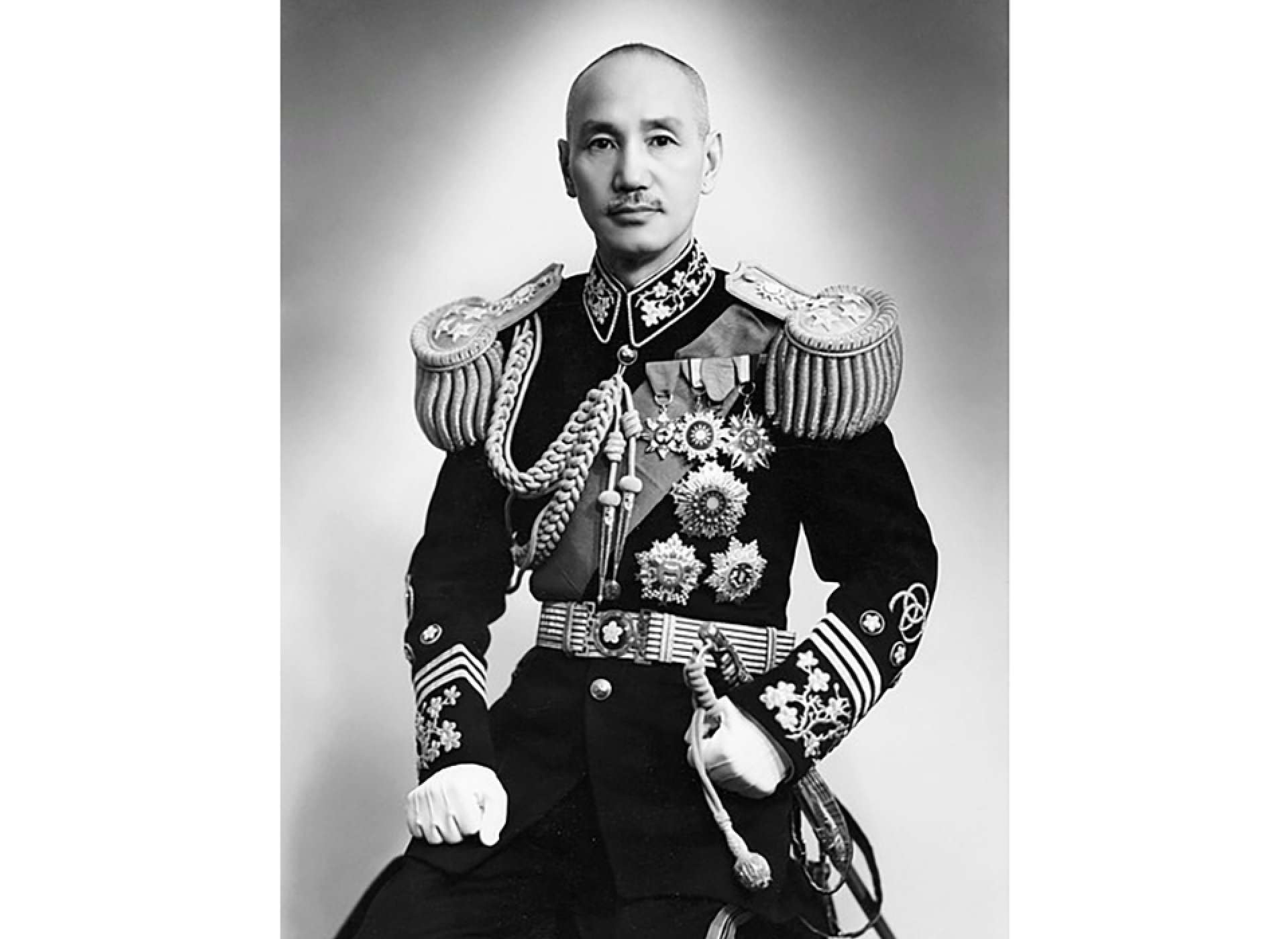
Chiang Kai-shek, 1943. Courtesy of Wikicommons.
What was supposed to be a quick victory against an overmatched army and a terrified population soon turned into something different, something Japan could least afford: a stalemate. Much of Northern and coastal China was in Japanese hands, but even with a million men in the field, Japan seemed no closer to victory.
III. Power Projection: the Move to Pearl
Another problem facing Japan was that China turned out to have a powerful friend, and eventual ally: the United States. The United States wasn’t always constant or fervent in its support, but it did offer help in China’s darkest days, and, with Great Britain and France tied up in their war with Germany after 1939, America was the lone power capable of thwarting Japanese plans in the Pacific.
President Franklin D. Roosevelt had been dealing with the Japan “problem” for a long time—his entire time in office, in fact. He was an internationalist to the core, believing in the law of nations, international cooperation for the greater good, and the sanctity of treaties. Along with those liberal tendencies in foreign policy, though, he was also a hard-headed strategist. He could hardly sit by and watch Japan conquer China, dominate the Western Pacific, and become the de facto ruler of mainland Asia. His real problem lay at home: the American people had little desire to get involved in any war, for any reason. It was the final heyday of isolationism, and FDR had to tread lightly.
And so he did what he could. He responded to Japanese aggression with economic warfare, placing an embargo on weapons sales to Japan in 1938, then broadening the embargo to include scrap iron and aviation fuel in 1940. FDR’s policy was designed to deter Japan from continuing on its path of aggression, but Japanese leadership only seemed emboldened, entering French Indochina in September 1940 (after the fall of France to Hitler) and hatching plans to seize other areas of Southeast Asia rich in raw materials.
In the fall of 1940, FDR made two crucial decisions. First, he decided to reinstate the draft, for one year only, while speaking words of reassurance to a nervous American public:
“I have said this before, but I shall say it again and again and again; your boys are not going to be sent into any foreign wars.”
Franklin D. Roosevelt
It was a start on repairing the country’s defenses, and despite some grumbling, the country went along.
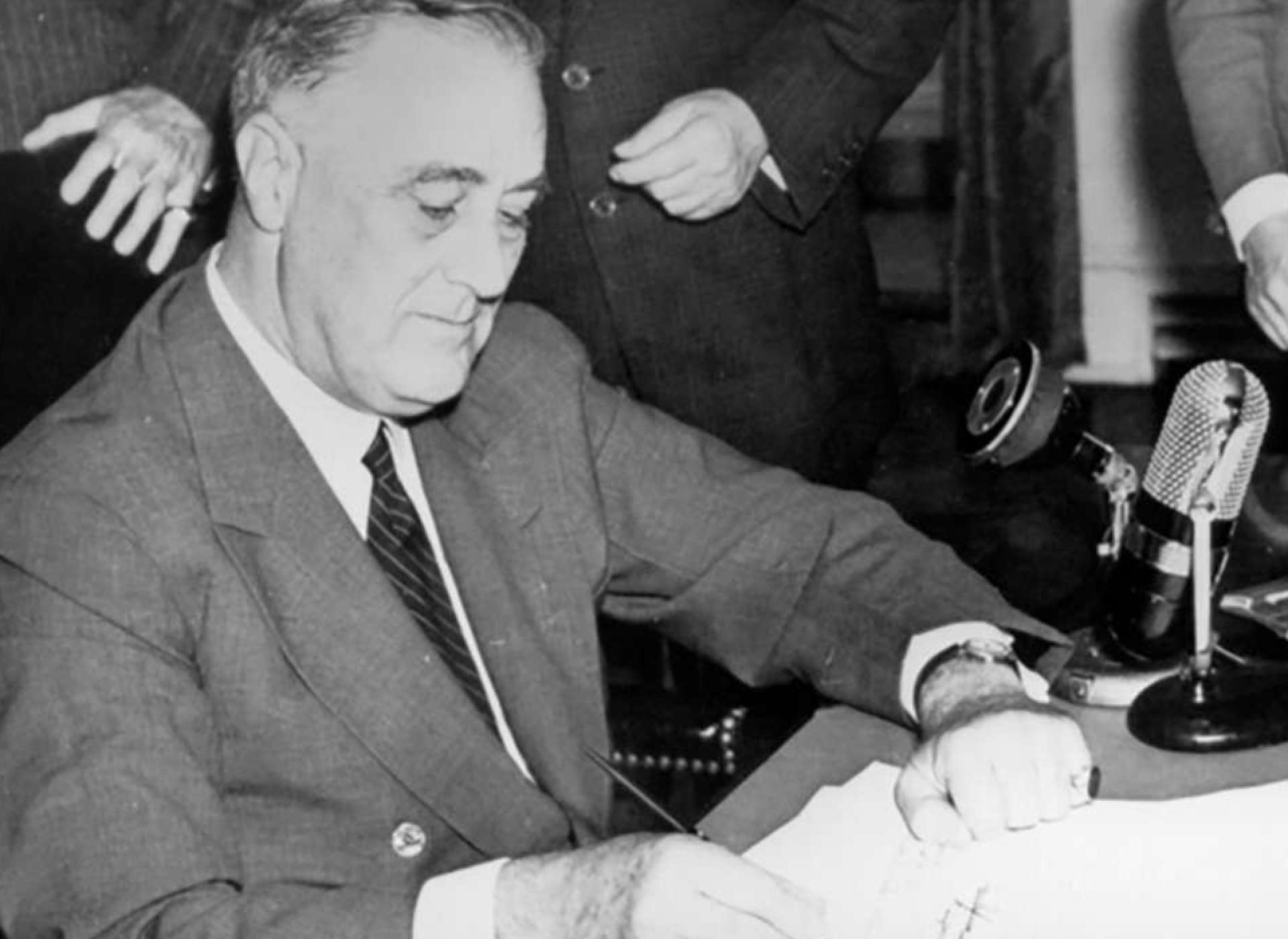
President Franklin D. Roosevelt signs the Selective Training and Service Act of 1940, creating the first peacetime draft. Image courtesy of the Selective Service System.
A second decision would be more fateful. He decided to move the US Navy’s Pacific Fleet from its homeport in San Diego, CA to a location deeper out into the Pacific. His purpose was to project strength against the Japanese. He started small, ordering the Navy to transfer two heavy cruiser divisions, two destroyer squadrons and an aircraft carrier to Pearl Harbor in the US possession of Hawaii. Roosevelt’s decision was easy to understand. Fleets are not only good for warfighting, they represent a way to send a message to would-be adversaries. Countries have been practicing “gunboat diplomacy” for millennia, even before there were gunboats, in fact.
Not everyone in the Navy was happy with the decision. As Admiral James Richardson, Commander in Chief, United States Fleet (CinCUS), saw it, Pearl was too far away, too isolated in the middle of a big ocean, and too vulnerable to a Japanese attack. He tried to dissuade FDR from the move to Pearl and failed. He tried again, even though he had to know he was pushing his luck. If he didn’t realize it, he found out in February 1941, when FDR relieved him of command.
The president had prevailed. The Pacific Fleet remained at Pearl.
IV. Widening the War
The year 1941 saw more of the same. Huge Japanese forces were stuck in China. US embargoes were biting into Japan’s economy, and US arms were starting to pour into China, courtesy of the new Lend-lease Act. They arrived via a new road hacked out of the mountains from the British colony of Burma to Chungking, the famous “Burma Road,” one of the century’s great engineering feats. Volunteer pilots from the US were also arriving in China, the American Volunteer Group, or “Flying Tigers.” China was bruised and battered, but still in the field, and, most important, it was not alone. Japan too had friends—it joined the Tripartite Pact with Germany and Italy in September 1940—but those two countries were far too distant and could provide Japan with no real material assistance. In the long run, Japan’s position was untenable.
That sense of losing its grip led to Japan’s next decision: to widen a war it believed it was losing. The Empire had to find some way to acquire the natural resources it needed to finish off the war with China. But how? Two strategies had traditionally presented themselves to Japanese planners. The first was to travel the so-called “Northern Road”: a thrust into Northeast Asia, especially into Mongolia and Siberia. The main enemy in this strategic vision was the USSR, of course, and it therefore required a greatly expanded army. No one should be surprised to learn that the Northern Road was the favored strategy of most Japanese army officers.
The second possible strategy was the “Southern Road,” this one predominant within the Imperial Japanese Navy. To the Navy, the natural path for Japanese economic and territorial expansion lay in Southeast Asia and the Pacific Islands. Japan was already a power in the latter, administering the Marshalls, Mariana, and Caroline Island chains in Pacific Micronesia. The Southern Road meant amphibious landings and naval warfare, and, once again, it’s no shock to learn that the Navy supported it.
We like to think we make strategic choices, but sometimes we wind up having no choice. For Japan, any real option had already disappeared in 1939. Japanese forces in Manchuria had been probing into Soviet-held Mongolia that spring, and the Soviets responded by beefing up forces in the area. At issue was a disagreement over the precise course of the border in this poorly mapped region. In the course of the spring, small skirmishes grew in intensity until a full-scale shooting war had broken out.
In four months of fighting, newly modernized Soviet forces, featuring tanks and aircraft and led by a very capable young general named G. K. Zhukov, encircled and destroyed most of the Japanese force in the area. Much of the action took place on the Khalkhin-Gol river, and that is the name that Russian-language historians gave the battle. The Japanese called it by the name of a tiny village near the battlefield, speaking of the “Nomonhan Incident.”
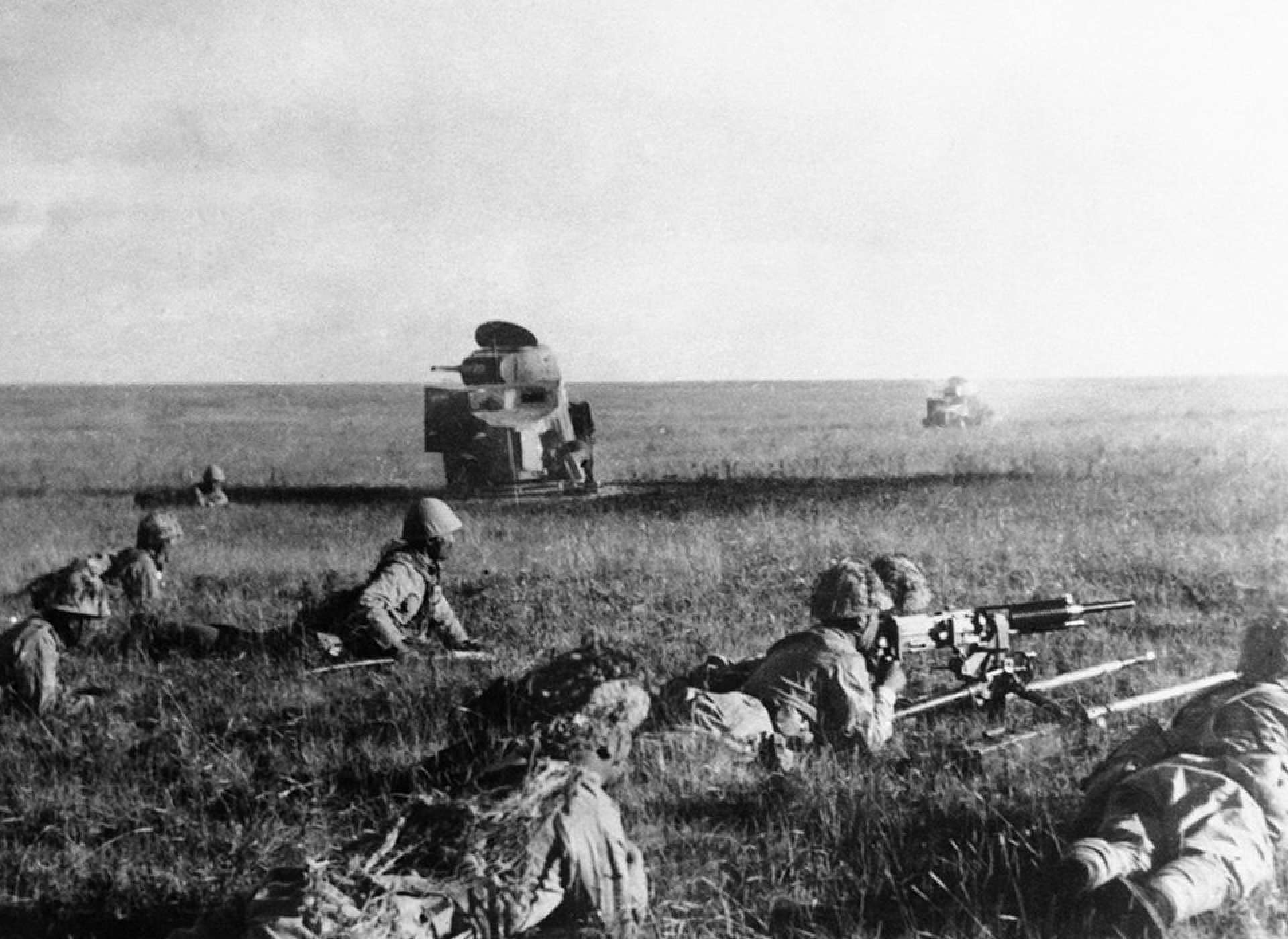
Japanese soldiers creeping in front of wrecked Soviet armored cars, July 1939. Courtesy of Dōmei Tsushin.
Call it what you will, the effects of Nomonhan were dramatic. The IJA had to concede that it was neither prepared nor equipped for large-scale continental warfare against a power like the USSR. The Soviets had employed modern technology, tanks, aircraft, modern guns; the Japanese had a handful of tanks and little air power. Instead, they had relied on the superior morale and fighting spirit of their infantry.
Such talk had been a staple of Japanese propaganda for some time: that a supposedly ancient culture of Bushido—the way of the Samurai—could substitute for the modern machines of war, that the Japanese had a superior martial spirit (“Yamato damashii”), that Japanese soldiers didn’t fear death, and would rather die than surrender. We should beware of taking any of these Japanese claims too literally. The Soviets certainly took Japanese prisoners at Khalkhin-Gol. Indeed, such claims were a form of propaganda, designed by Japanese commanders and tailored to a force that they knew was lacking in modern weapons and equipment.
With the northern strategy discredited, Japan eventually decided to turn south. Certainly, there was logic here. With the western powers tied down by their war versus Hitler, their Asian colonies were vulnerable. Japan saw a huge, once-in-a-century opportunity to seize the resources it needed: rubber from French Indochina, tin from British Malaya; the vast oil fields of the Dutch East Indies. Japan would finally have what it needed to end the China War.
Logical perhaps, but also the only real strategy left.
V. The Critical Time
Standing in the way of this new southern strategy was the US Navy, still getting settled into its new homeport in Pearl Harbor. Japanese strategic thinking ran something like this. Open the war with a lightning blow against the Americans, knocking the US fleet out of the picture temporarily. With the United States licking its wounds, launch a vast campaign of conquest in the South Pacific, and fortify the new conquests against the inevitable US counterattack. No US President in his right mind, Japanese planners believed, would try to reconquer the entire Pacific Ocean, island by island. Losses would be too high, and at any rate, Americans lacked the stomach for such a long, drawn-out war. They were too soft.
The summer of 1941 was the critical time. The dictators were clearly on the march. Hitler launched his invasion of the Soviet Union, Operation Barbarossa, in June. The next month, the Japanese occupied the southern half of Indochina. It was a clear sign that they were aiming south, towards the western colonies in Asia. Roosevelt’s response was swift. He froze all Japanese assets in the United States, a bold step that made it nearly impossible for Japan to purchase the most precious natural resource of all: oil. Without oil, Japan’s entire war machine would grind to a halt. Prosecuting the war in China would be impossible.
Japan’s response was not encouraging. In October 1941, a new Prime Minister came to power. Hideki Tojo was already the War Minister, and his appointment as political leader made it clear that military concerns would now be uppermost in Japanese considerations. While their military prepared for war, however, the Japanese also opened talks with Washington. Ambassador Kichisaburo Nomura and special envoy Saburō Kurusu would be fixtures on the Washington scene over the next few months, holding out the hope of a negotiated settlement until the very end.
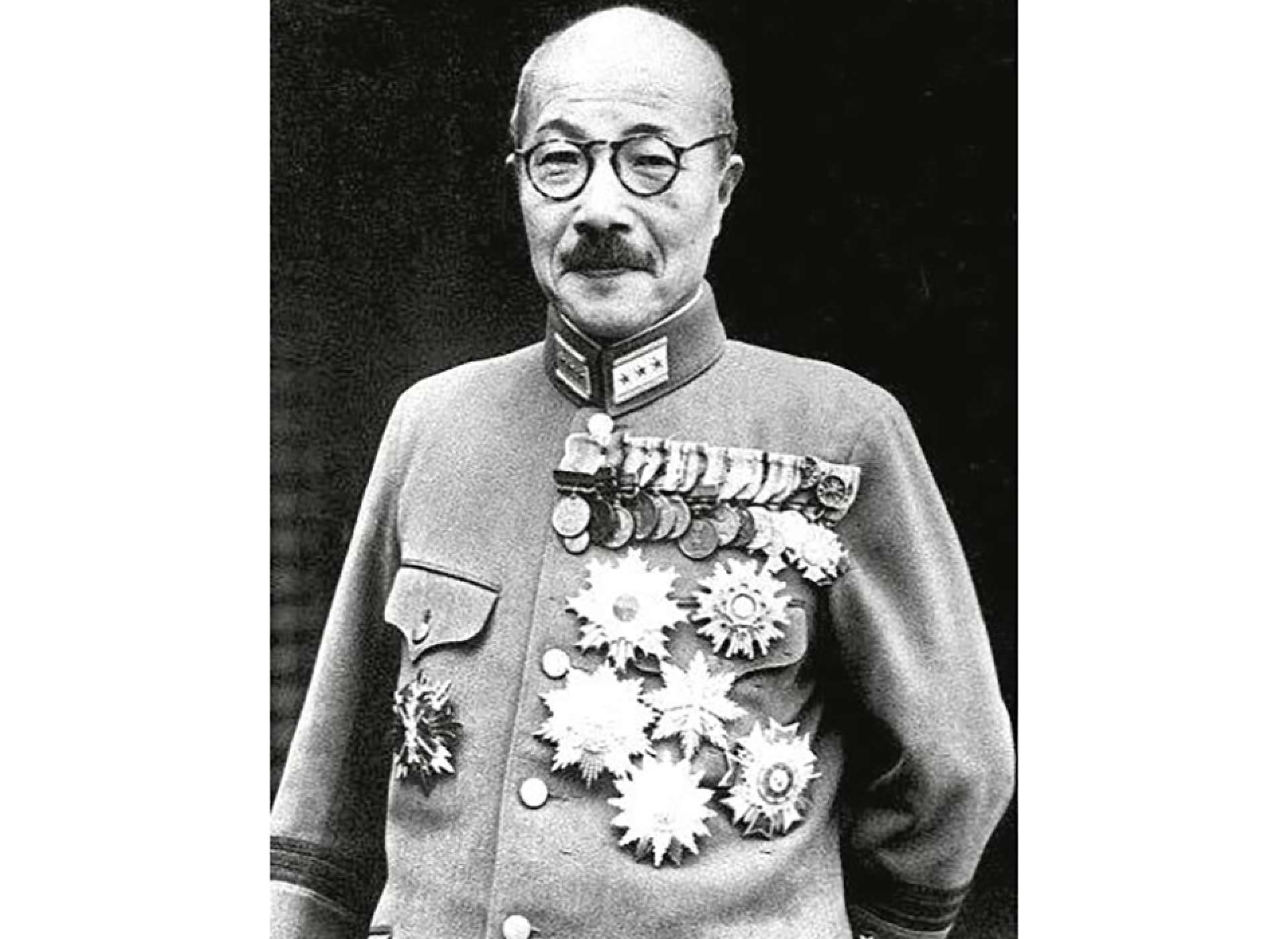
Hideki Tojo. Courtesy of Free Social Encyclopedia of the World.
The positions of the two countries were diametrically opposed, however, too far apart to be smoothed over by diplomatic talk. The crisis intensified. With Japan squeezed for oil, US Secretary of State Cordell Hull formulated a note to the Japanese government, an “Outline of Proposed Basis for Agreement Between the United States and Japan,” on November 26. This “Hull Note” contained some tough talk, including the demand that Japan “withdraw all military, naval, air and police forces from China and from Indochina.” Only then would the oil start flowing again.
Japan saw the note as an ultimatum which it had no intention of obeying, and besides, it had already laid its plans. On the very same day as the Hull Note arrived, a great fleet, including all six of Japan‘s big “fleet carriers,” departed Hitokappu Bay in the Kuril Islands. In command was Admiral Chuichi Nagumo. His operational target: Pearl Harbor. As he approached his designated station north of the Hawaiian islands, Japanese leaders held an “Imperial Conference,” a war planning session in the presence of the Emperor, on December 1. “We have been engaged in the China Incident for more than four years, and now we are going to get involved in a great war. We are indeed dismayed that we have caused His Majesty to worry,” Tojo told the Emperor.
Early on the morning of December 7, a seemingly peaceful Sunday, the Japanese attacked Pearl Harbor.
VI. Short Fuses and Miscalculations
Perhaps it was inevitable, this clash for mastery of the Pacific. Perhaps the entire sequence of events set in motion by the arrival of Perry’s fleet of “black ships” in 1853 could only have ended in one way.
This look at the “short fuse,” however, makes it plain how much of the run-up to Pearl Harbor was the result of improvisation, short-sighted policies, and even plain old human error, particularly on the Japanese side. The turn to terror in China—a substitute for having enough troops to patrol the countryside and protect supply lines during a difficult campaign—was a colossal example of blowback. The Chinese people chose to die on their feet rather than live on their knees as slaves to Imperial Japan. The Japanese assessment of the American foe as weak-minded materialists who whined for creature comforts and could never stand up to Japan’s martial spirit was a classic case of believing your own press releases, or in this case, your own propaganda. And finally, taking on a country whose economy was nearly 10 times the size of your own is rarely a good idea in any universe.
But Washington, too, had its share of misjudgments. Slapping an oil embargo on someone, given the shape of the modern international economy, is almost guaranteed to generate a strong reaction, and that’s precisely what happened. And while we can’t say for certain, President Roosevelt may well have spent the night of December 7, 1941 thinking about his fateful decision to move the fleet from its safe haven in San Diego to faraway Pearl Harbor. The first six months of the Pacific War showed that Americans, too, had their share of misconceptions about the Japanese enemy: that he was too short, too weak, and too nearsighted to stand up to modern combat on land, sea, and air. War has a way of stripping bare a lot of silly ideas, and this war definitely did.
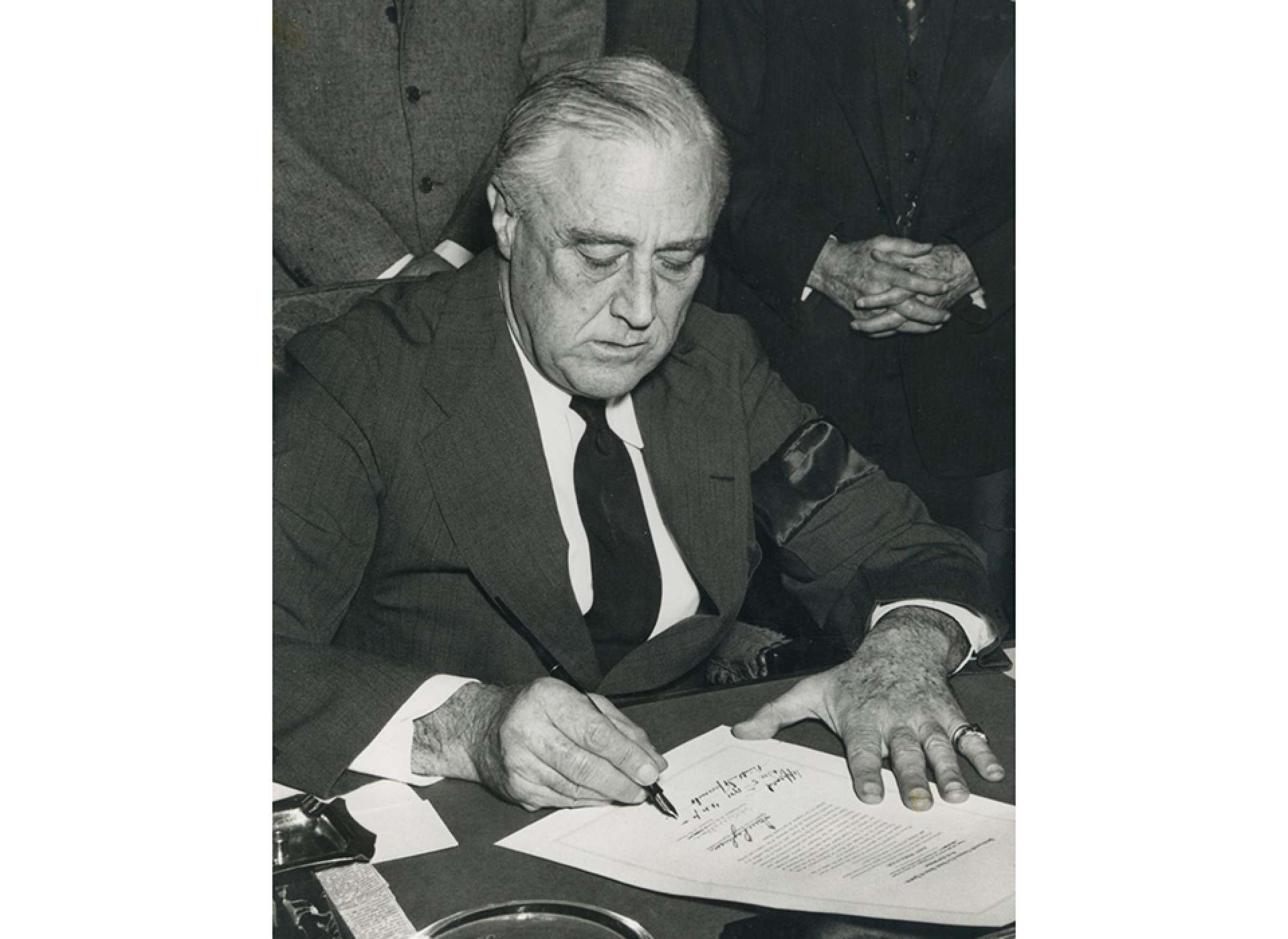
FDR signing the declaration of war against Japan on December 8, 1941. Courtesy of the National Archives.
Pearl Harbor was not only an event that decided the destiny of two great nations. The sudden appearance of those Japanese aircraft over O’ahu also reveals a great deal about the nature of history itself. The fuse can be burning a long time, but the explosion still comes as a shock.
Robert Citino, PhD
Robert Citino, PhD, is the former Samuel Zemurray Stone Senior Historian in the Jenny Craig Institute for the Study of War and Democracy.
Cite this article:
MLA Citation:
APA Citation:
Chicago Style Citation:
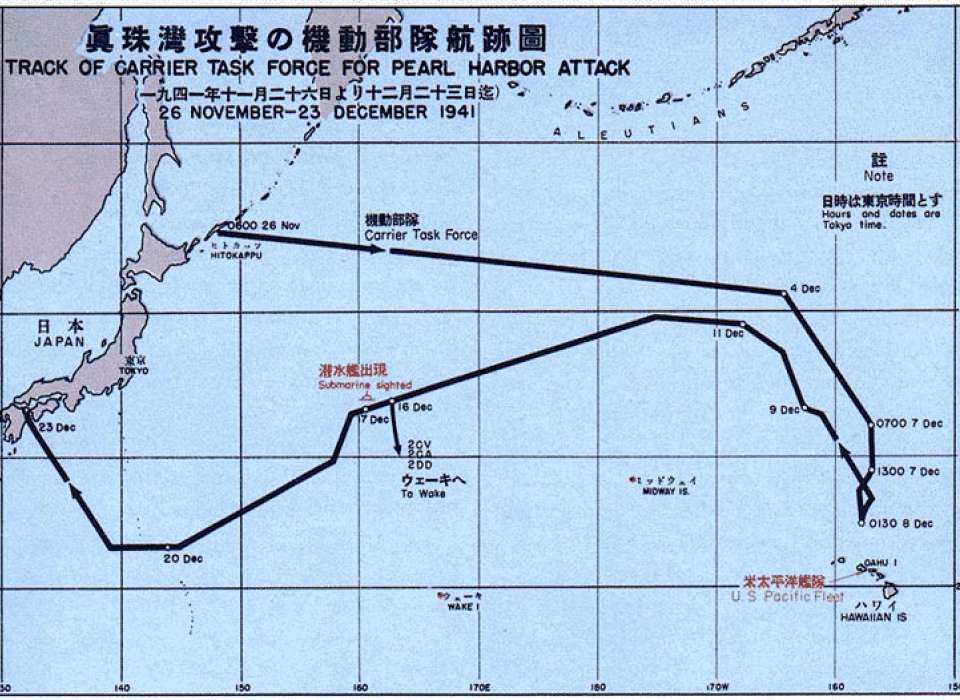





![Max Fuchs, New York City cantor, sings as Rabbi Sydney [sic] Lefkowitz, Richmond, VA, conducts the first Jewish services from Germany.](/sites/default/files/styles/max_650x650/public/2025-10/image1.jpg)


